Have you ever wondered why your feline friend enjoys belly rubs so much? Cats’ affinity for belly rubs has long puzzled cat owners, but there are some fascinating explanations behind this behavior. To understand why cats love belly rubs, we need to delve into their anatomy and psychology.
Cats are known for their independent and instinctual behaviors, and their bellies play a crucial role in their self-preservation. Unlike dogs, cats have a vulnerable belly region that they instinctively protect. This sensitivity can vary among cats, with some enjoying gentle belly rubs, while others may find it uncomfortable or even painful.
Building a strong bond of trust with your cat is essential for them to feel comfortable and relaxed, allowing them to enjoy belly rubs. It’s important to respect their boundaries and understand that not all cats will enjoy this type of interaction.
Key Takeaways:
- Not all cats enjoy belly rubs due to their sensitive bellies and individual preferences
- Cats instinctively protect their vulnerable bellies as a self-preservation mechanism
- Building trust and respecting boundaries is crucial for cats to feel comfortable with belly rubs
- Cats have unique personalities and preferences, so observing and respecting their individuality is important
- Understanding cat behavior and body language is key to deciphering their affection for belly rubs
The Sensitivity of Cats’ Bellies
When it comes to cats and their bellies, there’s more than meets the eye. Understanding the sensitivity of cats’ bellies is crucial in deciphering their preferences for belly rubs. Cats have a high concentration of nerve endings in their belly region, making it an incredibly sensitive area for them.
This sensitivity varies from cat to cat, with some felines enjoying gentle belly rubs and others finding it uncomfortable or even painful. It’s important to respect each cat’s individual preferences and boundaries when it comes to belly contact. Just like humans, cats have unique personalities, and not all of them will enjoy belly rubs.
By observing your cat’s body language and cues, you can determine their comfort level with belly rubs. If your cat shows signs of relaxation, such as rolling over and exposing their belly, it may be an indication that they enjoy belly rubs. However, if they tense up or show signs of discomfort, it’s best to refrain from touching their belly.

The Sensitivity of Cats’ Bellies
To summarize, cats’ bellies are highly sensitive due to the abundance of nerve endings in their skin. This sensitivity varies among cats, with some enjoying gentle belly rubs and others finding it uncomfortable. It is essential to respect each cat’s individual preferences when it comes to belly rubs and understand that not all cats will enjoy this type of interaction.
Self-Preservation Instinct
Cats have a natural self-preservation instinct that guides their behavior, including their response to belly rubs. Due to the vulnerability of their bellies, cats instinctively protect this area as a means of defense. When humans attempt to touch their bellies, some cats may interpret it as a potential threat and react defensively. This defensive response can manifest as swatting, biting, or scratching.
Decoding cat body language is crucial in understanding their comfort level with physical contact. Signs of discomfort or distress include flattened ears, dilated pupils, a swishing tail, or a tense body posture. It’s important for cat owners to respect their cats’ boundaries and avoid forcing unwanted belly rubs if their cats display these signs of discomfort.
Building trust with your cat is essential for them to feel secure enough to allow belly rubs. This trust is developed through patience, consistent positive interactions, and respecting their individual preferences. Every cat is unique, and while some cats may enjoy belly rubs as a sign of affection, others may have different preferences for physical contact.
| Signs of a Trusting and Comfortable Cat: | Signs of a Discomfort and Defensive Cat: |
|---|---|
| Relaxed posture with an elevated tail | Flattened ears and dilated pupils |
| Exposed belly, often accompanied by stretching | Tense body posture and tail swishing |
| Soft purring or gentle kneading | Growling, hissing, or swatting |
Trust and Comfort
Building trust with your cat is crucial for them to feel comfortable and relaxed around you. Cats are known for their independent nature, and earning their trust takes time and patience. Once a strong bond is formed, some cats may enjoy belly rubs as a sign of affection and trust.
Respecting your cat’s boundaries is essential when it comes to belly rubs. Not all cats will enjoy this type of interaction, and forcing unwanted belly rubs can erode trust and cause unnecessary stress. It’s important to observe your cat’s body language and cues to determine their comfort level with physical contact.
Some cats may show their bellies as a way to cool down or stretch their muscles, rather than an invitation for belly rubs. By paying attention to your cat’s individual preferences and respecting their personal space, you can create a harmonious and trusting relationship.
Table: Signs of Trust in Cats
| Signs of Trust | Description |
|---|---|
| Purring | Cats may purr when they feel safe and content, indicating a level of trust. |
| Head Bumps | Cats may rub their heads against you, marking you as part of their territory and showing trust. |
| Slow Blinking | A slow blink is a sign of relaxation and trust. Cats may close their eyes halfway and hold the position for a few seconds. |
Remember, each cat is unique, and their preferences may vary. It’s important to give your cat the space and freedom to choose whether they enjoy belly rubs or not. By understanding and respecting your cat’s boundaries, you can cultivate a strong and trusting bond that will bring you both joy and companionship.
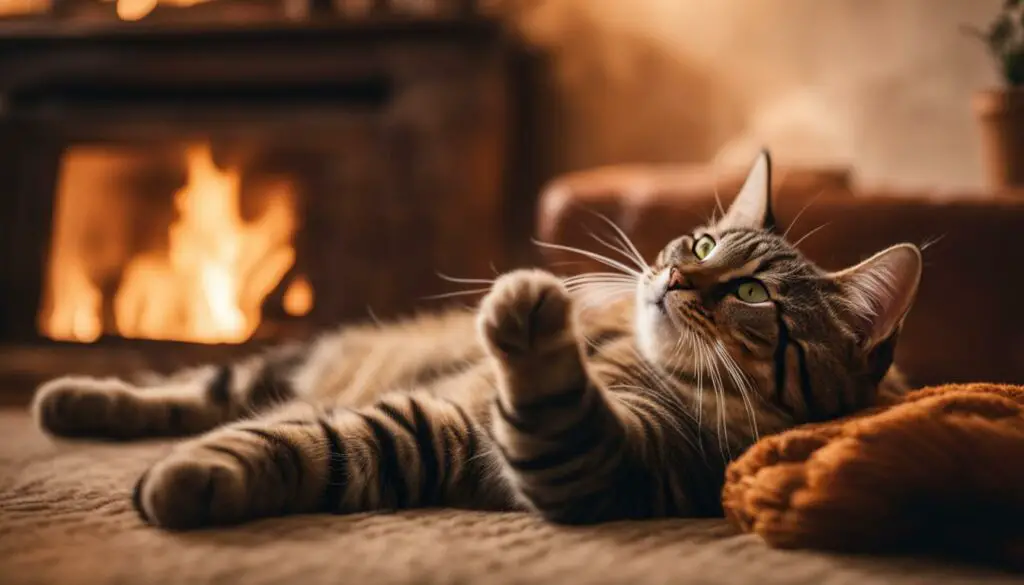
Individual Preferences
Just like humans, cats have their own unique preferences when it comes to belly rubs. While some cats may absolutely love them, others may not enjoy this type of interaction. It’s important for cat owners to observe and respect their cats’ individual preferences instead of forcing unwanted interactions upon them.
Factors Influencing Cat Belly Rub Preferences
There are several factors that can influence a cat’s preference for belly rubs. One of the main factors is their level of sensitivity in the belly region. Cats have an abundance of nerve endings in their skin, making their bellies highly sensitive. Some cats may find gentle belly rubs pleasurable, while others may find them uncomfortable or even painful.
Another factor is their trust and comfort level with their owners. Cats who have established a strong bond of trust with their owners may be more open to belly rubs as a form of affection. On the other hand, cats who are less trusting or who have had negative experiences in the past may be more reluctant to engage in this type of interaction.
Respecting Your Cat’s Preferences
Respecting your cat’s individual preferences is crucial for maintaining a positive and healthy relationship with your feline companion. It’s important to pay attention to your cat’s body language and cues to determine their comfort level with belly rubs. Some cats may exhibit signs of enjoyment, such as relaxed body posture and purring, while others may show signs of discomfort or stress, such as tense muscles or trying to move away.
Instead of forcing belly rubs upon your cat, it’s important to find alternative forms of interaction that they find enjoyable. This could include gentle head scratches, chin rubs, or simply spending quality time together in a way that aligns with their preferences. Remember, each cat is unique, and it’s essential to respect their boundaries and preferences to maintain a harmonious relationship.
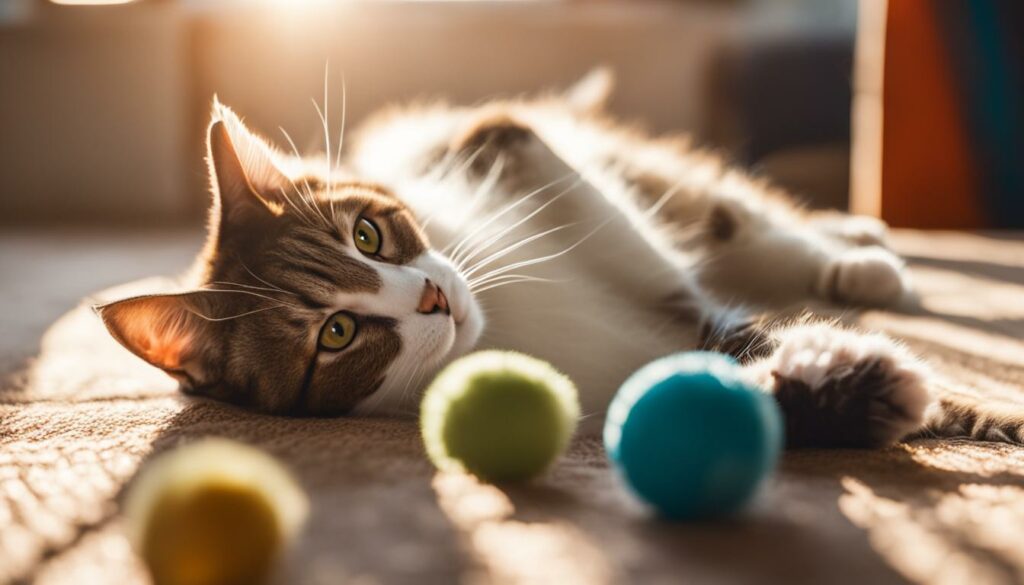
| Pros of Belly Rubs | Cons of Belly Rubs |
|---|---|
| Can be a form of affection and bonding | Some cats find it uncomfortable or painful |
| May help reduce stress and anxiety | Can trigger defensive or aggressive behavior in some cats |
| Allows for physical contact and grooming | Not all cats enjoy belly rubs and may prefer other forms of interaction |
Understanding the Aversion: Unraveling the Mystery Behind Cats’ Disdain for Belly Rubs
While some cats absolutely adore belly rubs, others show a clear aversion to this form of affection. To understand why some cats dislike belly rubs, we need to consider a combination of factors. It’s important to keep in mind that each cat is unique and may have their own preferences and sensitivities.
One possible explanation for cats’ aversion to belly rubs is their sensitive bellies. Cats have a high concentration of nerve endings in their abdomen, making it a particularly sensitive area. Some cats may find direct contact or pressure on their bellies uncomfortable or even painful.
Another factor to consider is cats’ self-preservation instinct. The belly is a vulnerable area for cats, and they naturally protect it. When approached for a belly rub, some cats may interpret it as a potential threat and react defensively to avoid any harm. This instinctual behavior is essential for their survival in the wild.

Additionally, cats have individual preferences and personalities. Just like humans, not all cats enjoy the same types of physical contact. Some may prefer gentle head scratches or chin rubs over belly rubs. It’s essential to respect and understand your cat’s individual preferences, allowing them to dictate the level of affection they are comfortable with.
By considering the sensitivity of their bellies, their self-preservation instincts, and their individual preferences, we can begin to unravel the mystery behind cats‘ aversion to belly rubs. It’s important to approach each cat with understanding, respect their boundaries, and provide them with the affection and interaction they truly enjoy.
Do Cats Trust You If They Show Their Belly?
When a cat shows its belly, it can often be seen as a sign of trust and vulnerability. As a cat owner, it’s important to understand that this behavior doesn’t always mean they want belly rubs. Instead, it is a way for them to communicate their comfort and relaxation in your presence. Cats have a unique body language, and interpreting their cues correctly is key to fostering a strong bond with your feline companion.
Decoding cat body language is essential to understanding their intentions. Showing their belly can also be a way for cats to cool down or stretch their muscles. It’s important to pay attention to other signs of comfort, such as relaxed ears and slow, confident movements. If a cat’s body language indicates they are at ease, you can approach them gently and offer belly rubs if they seem receptive.
“Understanding the meaning behind a cat showing its belly requires observation and respect for their boundaries. It is not an invitation for every cat to be touched. Each cat has its own unique preferences and comfort levels with physical contact,” says veterinarian Dr. Emily Johnson.
Remember, it’s crucial to let the cat take the lead when it comes to physical contact. Some cats may enjoy gentle belly rubs, while others may prefer alternative forms of affection, such as chin rubs or head scratches. Respecting their individual preferences is essential for maintaining trust and building a strong bond with your feline companion.
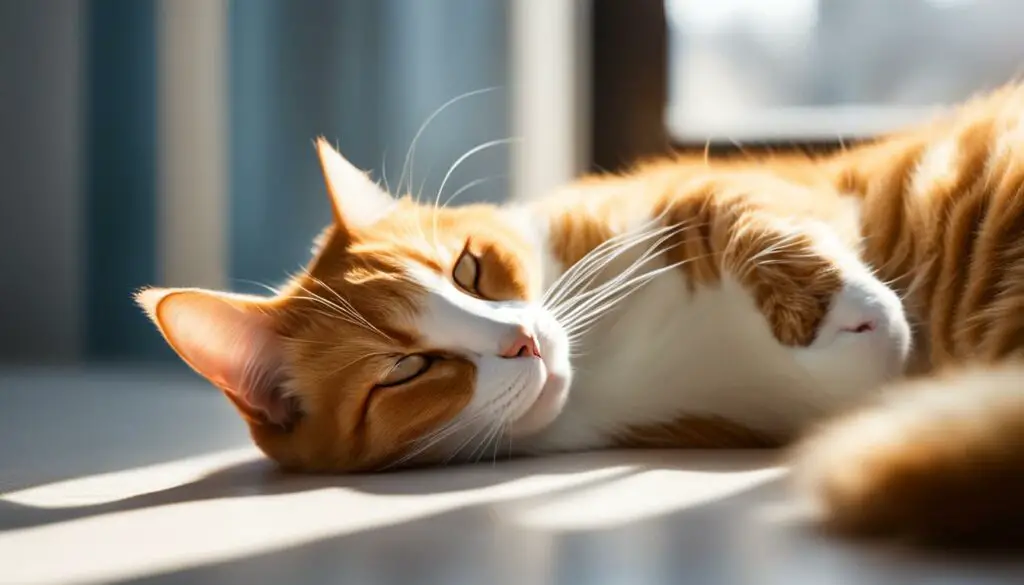
Decoding Cat Body Language
Cats communicate through their body language, and understanding their cues is fundamental to interpreting their behavior. Here are some key body language signals to look out for:
- Tail position: A relaxed, upright tail usually indicates a content and confident cat. A twitching or tucked tail may signal fear or agitation.
- Ear position: Ears held forward typically show attentiveness and interest. Flattened or backward ears can indicate fear or displeasure.
- Pupil dilation: Dilated pupils often suggest excitement or arousal, while constricted pupils can mean fear or aggression.
- Body posture: A relaxed, loose posture indicates a calm and content cat. Arched back and puffed-up fur may signify fear or aggression.
- Vocalizations: Cats use various vocalizations, such as purring, meowing, or hissing, to express their emotions and needs. Each vocalization has its own meaning and context.
By observing and understanding your cat’s body language, you can better interpret their actions and respond appropriately. Remember, every cat is unique, so it’s important to pay attention to their individual preferences and comfort levels. This will help you establish a strong and trusting relationship with your feline friend.
| Body Language Signal | Meaning |
|---|---|
| Relaxed tail | Content and confident |
| Twitching or tucked tail | Fear or agitation |
| Ears held forward | Attentiveness and interest |
| Flattened or backward ears | Fear or displeasure |
| Dilated pupils | Excitement or arousal |
| Constricted pupils | Fear or aggression |
| Relaxed, loose posture | Calm and content |
| Arched back and puffed-up fur | Fear or aggression |
Understanding Feline Behavior: Deciphering the Meaning Behind Cats Allowing Belly Touches
When a cat allows you to touch their belly, it signifies a level of comfort and trust between you and your feline companion. This gesture is a strong indication that your cat feels safe and relaxed in your presence. However, it is essential to approach belly touches with caution and respect their individual preferences.
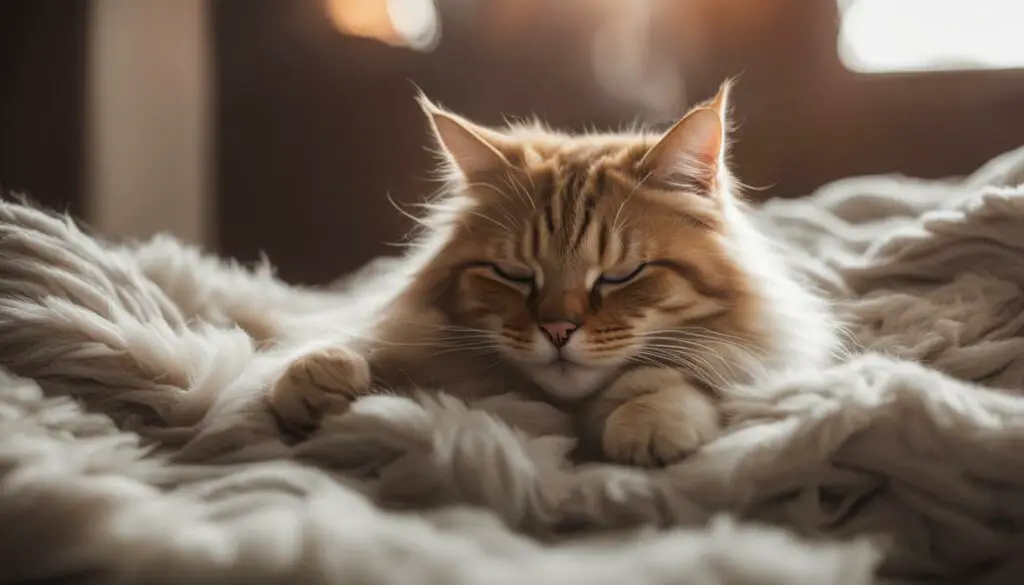
Just as humans have personal boundaries, cats also have their own comfort zones. Some cats may enjoy belly rubs and willingly expose their bellies, while others may be more reserved and prefer different forms of interaction. It is important to observe your cat’s body language and cues to determine their comfort level with physical contact.
If your cat allows you to touch their belly, it is a testament to the bond you have created with them. Cats are naturally independent animals, so their willingness to expose their vulnerable belly signifies a deep trust. However, it is crucial to remember that not all cats enjoy belly rubs, and it is essential to respect their boundaries. Forcing unwanted belly rubs can erode trust and cause undue stress.
The Importance of Respect
Respecting your cat’s preferences and boundaries is key to maintaining a harmonious relationship. While some cats may enjoy belly rubs, others may find them uncomfortable or even painful. It is crucial to listen to your cat and avoid pushing them beyond their comfort levels. By understanding and respecting their individual preferences, you can strengthen the bond you share with your feline companion.
| Benefits of Belly Touches | Things to Consider |
|---|---|
|
|
Understanding Feline Perception: Unraveling the Mystery of Cat Recognition
When it comes to recognizing their owners, cats have a unique way of perceiving the world. They rely on a combination of senses, including scent, visual cues, and body language, to identify familiar individuals. By understanding their perception, we can gain valuable insights into their behaviors and preferences.
Cats have an acute sense of smell, and they use scent to recognize their owners. They are able to pick up on the unique scent that each individual carries, allowing them to distinguish between familiar and unfamiliar people. This is why cats often sniff their owners’ hands or clothing when they return home, as a way of confirming their identity.
In addition to scent, cats also rely on visual cues to recognize their owners. They are able to recognize familiar faces and body shapes, even from a distance. This is why cats may approach their owners with a sense of familiarity and comfort, even if they have been apart for a while. This visual recognition is especially strong when combined with positive experiences and interactions, reinforcing the bond between cat and owner.
Body language also plays a crucial role in cat recognition. Cats are highly observant of their owners’ movements, posture, and gestures. They pay attention to the way their owners walk, talk, and interact with them. By decoding their owners’ body language, cats are able to establish a sense of familiarity and trust.
Overall, understanding how cats perceive and recognize their owners can deepen our understanding of their behaviors and preferences. By paying attention to their unique ways of perceiving the world, we can strengthen the bond with our feline companions and provide them with a nurturing and enjoyable environment.
| Perception | Key Points |
|---|---|
| Scent | – Cats use scent to recognize their owners – They rely on the unique scent of each individual – Sniffing is a way of confirming identity |
| Visual Cues | – Cats recognize familiar faces and body shapes – Visual recognition strengthens the bond – Positive experiences reinforce recognition |
| Body Language | – Cats pay attention to owners’ movements and gestures – They decode body language to establish familiarity – Observing interactions builds trust |
Understanding Feline Behavior: Unraveling the Mystery of Litter Tray Aversion
When it comes to our feline companions, litter tray aversion can be a perplexing issue. Understanding why cats may develop an aversion to using the litter tray is crucial for cat owners to provide a clean and appropriate environment for their furry friends. Let’s explore some of the factors that contribute to litter tray aversion and how we can address them.
Common Factors Contributing to Litter Tray Aversion
There can be several reasons why a cat may develop an aversion to using the litter tray. These can include:
- Dirty litter tray: Cats are naturally clean animals, and a dirty litter tray can be a major turn-off. Regularly cleaning and scooping the litter tray is essential to ensure your cat feels comfortable using it.
- Location and privacy: Cats prefer a quiet and secluded area for their litter tray. Placing it in a busy or noisy spot may discourage them from using it. Ensure the litter tray is placed in a calm and private location.
- Litter type and depth: Cats can be very particular about the type of litter and its depth. Experiment with different litter options and depths to find the one that your cat prefers.
- Stress or medical issues: Cats may avoid the litter tray if they are experiencing stress or have underlying medical issues such as urinary tract infections. If your cat’s aversion persists, it’s important to consult with a veterinarian to rule out any underlying health problems.
Tips for Addressing Litter Tray Aversion
To help your cat overcome litter tray aversion, consider the following tips:
- Ensure the litter tray is clean and free of odor by scooping it daily and completely changing the litter regularly.
- Place the litter tray in a quiet and private area of the house where your cat feels safe and secure.
- Experiment with different litter types and depths to find the one that your cat prefers.
- If your cat shows signs of stress or discomfort, consult with a veterinarian to rule out any underlying medical issues.
- Consider providing multiple litter trays in different areas of the house to give your cat options and prevent competition with other pets.
By understanding and addressing the factors that contribute to litter tray aversion, we can create a comfortable and hygienic environment for our feline friends, promoting their well-being and happiness.
| Factors Contributing to Litter Tray Aversion | Tips for Addressing Litter Tray Aversion |
|---|---|
| Dirty litter tray | Ensure the litter tray is clean and free of odor by scooping it daily and completely changing the litter regularly. |
| Location and privacy | Place the litter tray in a quiet and private area of the house where your cat feels safe and secure. |
| Litter type and depth | Experiment with different litter types and depths to find the one that your cat prefers. |
| Stress or medical issues | If your cat shows signs of stress or discomfort, consult with a veterinarian to rule out any underlying medical issues. |
| – | Consider providing multiple litter trays in different areas of the house to give your cat options and prevent competition with other pets. |

Remember, patience and understanding are key when addressing litter tray aversion. By creating a clean, comfortable, and stress-free litter tray environment, you can help your cat feel more at ease and ensure their litter tray habits remain healthy and consistent.
Understanding Feline Discomfort: Unveiling the Mystery Behind Cats’ Aversion to Car Rides
Many cat owners have experienced the challenges of taking their feline companions on car rides. Cats, known for their independent nature, often exhibit discomfort and stress during travel. To better understand this behavior, it is essential to delve into the intricacies of cat behavior and their unique reactions to car rides.
One of the primary reasons why cats may dislike car rides is motion sickness. Just like humans, cats can experience nausea and discomfort when subjected to the motion and vibrations of a moving vehicle. This can cause anxiety and aversion towards car rides, leading to symptoms such as restlessness, excessive drooling, and even vomiting.
Another factor contributing to cats’ aversion to car rides is the fear of unfamiliar environments. Cats are creatures of habit and feel most comfortable in familiar surroundings. The unfamiliar sights, sounds, and smells of a car ride can be overwhelming and trigger anxiety in cats, leading to resistance and stress.
Past negative experiences can also play a significant role in cats’ dislike of car rides. If a cat has previously encountered a traumatic event or discomfort during travel, they may associate car rides with negative emotions and try to avoid them at all costs. These associations can be challenging to overcome and require patience and desensitization techniques to help cats feel more at ease during travel.
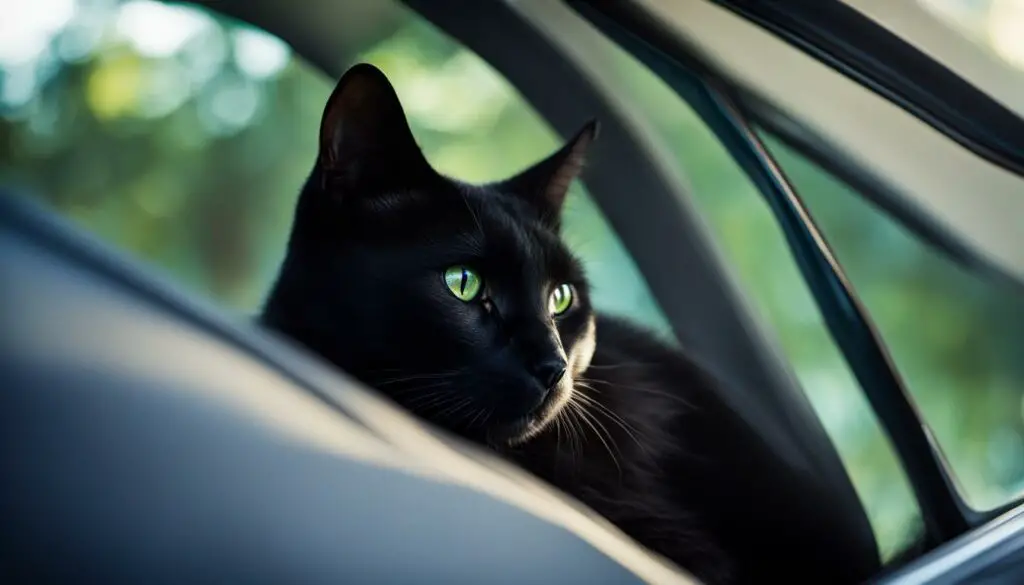
The Impact of Proper Preparations
While cats’ aversion to car rides may seem challenging, there are steps that cat owners can take to make the experience more comfortable. Using a secure and well-ventilated cat carrier can provide a sense of safety and security for the cat during travel. Additionally, introducing the cat to the carrier and car gradually, starting with short trips around the block, can help desensitize them to the unfamiliar environment and reduce anxiety.
Providing familiar scents, such as a blanket or toy from the cat’s safe space, can also help comfort them during car rides. These scents provide familiarity and reassurance, making the cat feel more at ease in an otherwise unfamiliar environment.
Finally, it is essential to minimize stressors during car rides by driving smoothly and avoiding sudden stops or turns. Calming aids, such as pheromone sprays or natural remedies, may also be beneficial in reducing anxiety and promoting relaxation during travel.
Summary
Cats’ aversion to car rides can be attributed to factors such as motion sickness, fear of unfamiliar environments, and past negative experiences. Understanding and addressing these factors can help cat owners create a more comfortable and stress-free travel experience for their feline companions. By taking the necessary preparations, introducing gradual exposure, and providing familiar scents and calming aids, cat owners can help alleviate their cats’ discomfort and make car rides a more positive experience overall.
Understanding the Behavior: Unraveling the Mystery Behind Floppa Cats’ Hissing
Floppa cats, known for their relaxed and friendly nature, may occasionally display hissing behavior. While it can be alarming for cat owners, it’s essential to understand the underlying reasons behind this behavior. Hissing is typically a cat’s way of expressing fear, feeling threatened, or discomfort. It serves as a warning signal to potential threats, signaling that they are ready to defend themselves if necessary. As cat owners, it’s crucial to respect their boundaries, provide a calm and secure environment, and address any underlying issues that may be causing the hissing behavior.
Hissing is a natural defensive response for cats and should not be misinterpreted as aggression. It is their way of communicating their discomfort or fear and should be taken seriously. It’s important to observe the cat’s body language when they hiss, as it can provide valuable insights into their state of mind. This behavior can occur when they feel cornered, overwhelmed, or when they are not given sufficient personal space. By recognizing and responding appropriately to their hissing, cat owners can help alleviate their anxiety and establish a sense of trust and security.
The Role of Socialization and Past Experiences
It’s important to note that a kitten’s early socialization plays a key role in shaping their behavior as adults,” says Dr. Emily Johnson, a feline behavior specialist. “Negative experiences in their past, such as abuse or neglect, can also contribute to their tendency to display defensive behaviors like hissing.”
Understanding a cat’s past experiences can help provide essential context for their behavior. It is crucial for cat owners to create a safe and nurturing environment for their floppa cats, building trust over time. Patience, positive reinforcement, and gradual exposure to new experiences can help reduce anxiety and decrease the likelihood of hissing episodes. Seeking guidance from a professional feline behaviorist can also be beneficial in managing and addressing more complex behavioral issues.
| Common Triggers for Hissing | Ways to Minimize Hissing |
|---|---|
| Overstimulation | Recognize their body language and give them space |
| Pain or discomfort | Consult a veterinarian to rule out any underlying medical conditions |
| Unfamiliar environments or people | Introduce new stimuli gradually and provide a safe space for retreat |
| Threats from other animals | Ensure a safe and peaceful environment for the cat |
By understanding the behavior behind floppa cats’ hissing and taking appropriate measures to address their needs and concerns, cat owners can foster a harmonious and loving relationship with their feline companions.
Conclusion
Understanding cat behavior and body language is essential for building a strong bond with our feline companions. By observing and respecting their individual preferences, we can create a nurturing environment where they feel comfortable and secure.
Cats’ affinity or aversion to belly rubs is influenced by various factors, including their sensitive bellies, self-preservation instincts, and unique personalities. While some cats may enjoy gentle belly rubs as a sign of trust and relaxation, others may find it uncomfortable or even painful.
By interpreting their body language and cues, we can determine whether our cats are open to physical contact or prefer alternative forms of interaction. It’s important to remember that each cat is different and should be approached with understanding and respect.
By understanding our cats’ anatomy, instincts, and preferences, we can navigate their world more effectively and provide them with the love and care they deserve. So let’s continue to observe, learn, and cherish our feline friends, ensuring their happiness and well-being.
FAQ
Why do some cats enjoy belly rubs?
Cats’ love for belly rubs can vary from cat to cat. Some cats enjoy belly rubs because it feels comforting and pleasurable to them. It is a way for them to bond with their owners and receive physical affection.
Why do some cats not like belly rubs?
Cats have sensitive bellies, and some may find belly rubs uncomfortable or even painful. It is important to respect each cat’s individual preferences and not force unwanted physical contact.
How can I tell if my cat likes belly rubs?
Watch for signs of relaxation and enjoyment, such as purring, kneading, and leaning into the rub. However, it’s crucial to pay attention to their body language and cues to understand their comfort level with physical contact.
How can I build trust with my cat to make them more comfortable with belly rubs?
Building trust with your cat takes time and patience. Create a calm and secure environment, provide positive reinforcement, and allow your cat to approach belly rubs on their terms. Respect their boundaries and never force unwanted physical contact.
My cat shows their belly, does that mean they want belly rubs?
Not necessarily. While showing their bellies can be a sign of trust and vulnerability, it is not an invitation for belly rubs from all cats. Some may simply be stretching or cooling down. It’s important to interpret their body language and cues to understand their comfort level with physical contact.
What should I do if my cat doesn’t like belly rubs?
Respect your cat’s boundaries and find other ways to interact and bond with them. Some cats may prefer gentle head scratches or chin rubs. It’s crucial to observe and respect your cat’s individual preferences instead of forcing unwanted interactions upon them.
Source Links
- https://misgatosyyo.com/us/why-do-cats-hate-belly-rubs/
- https://meowa.com/why-does-my-cat-lay-on-my-chest/
- https://be.chewy.com/decoding-cats-body-language/








